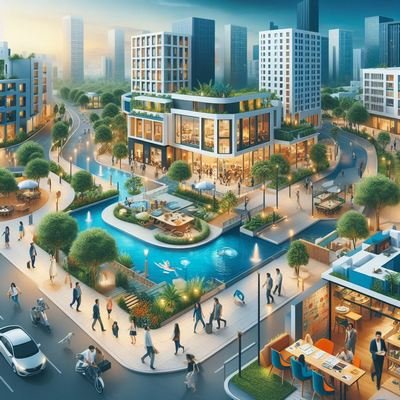By – Akash Pharande, Managing Director – Pharande Spaces

One important feature changing how people live and work in India’s fast-urbanizing terrain is the incorporation of commercial areas into residential townships. While this concept – which combines residential areas with workplaces, shops, and recreational areas – is not new, its uptake has sped up recently, particularly in the wake of COVID-19.
Evolution and Origins
Mixed-use projects are nothing new to India; even in pre-independence India, residential areas and bazaars coexisted together. But in the early 2000s, integrated townships, as they are now known, started to take off. Encouraged by India’s economic expansion and rapid urbanization, developers realized the benefits of creating an all-encompassing residential experience for the growing middle class.
This trend became even more evident after the 2008 financial crisis. This is when forward-thinking builders began to seek out ways to make projects more profitable and desirable. Including residential and commercial areas into one complex promised to boost footfall in retail malls by providing a captive market for retailers. Office buildings within the same precincts gave homeowners the possibility of walking, bicycling to work, or taking a short drive there with no traffic woes to contend with.
The COVID-19 epidemic kicked off a major move towards remote work, less crowded residential areas with sufficient greenery, the convenience and safety of having necessary retail outlets within easy reach, and small commutes to work. In short, the pandemic solidified the already strong attraction for integrated townships.

The Coworking Revolutions
Residential-commercial complexes like integrated townships are becoming all the more relevant because of the increasing popularity of coworking. If we take Pune as an example, the relevance and impact of coworking is hard to miss.
This city has evolved massively from its previous tags of ‘Oxford of the East‘ and ‘Pensioner’s Paradise’. Pune’s vibrant educational institutions and IT/ITeS sector generate and attract more and more young professionals and millennial entrepreneurs. Simultaneously, even some of the biggest MNCs in Pune have been looking at cutting costs after COVID-19.
Coworking spaces are the logical solution to bring down corporate costs and provide a fertile environment for collaboration, networking, and creative engagement. The most successful ones are located in and around residential catchments, so their availability in integrated townships is a win-win proposition.
Pune has been seeing steady growth in the coworking segment, with more operators of varying sizes constantly entering the fray. Especially after COVID-19, the coworking solution has found favour with many companies as well as the city’s growing young population. Pune’s thriving startup culture has contributed hugely to its growing popularity, as have the gig economy and service-based companies such as digital marketing, automobiles, and blockchain.
Not surprisingly, leading property consultants reported that 2021 saw a no less than 30% increase in demand for integrated townships over the same period the year before. Where work-from-home (WFH) has become ingrained, especially in metros and tier-1 cities, this rise is significant. Compared to exclusively residential projects, mixed-use townships have seen higher residential sales following the epidemic.

Integrated commercial-residential townships are growing in popularity in India because of:
– Work-Life Balance: Integrated townships encourage a healthy it by merging living and recreational areas, and minimizing travel time to and from work. This is something that the modern workforce appreciates more and more.
– A Sustainable Lifestyle: Sustainable living is becoming more and more important to urban Indians. Mixed-use townships lessen the need for driving and therefore have a lower carbon footprint overall. The more modern integrated townships also offer advanced green features such as wastewater recycling, use of solar lighting and heating, green areas to act as lung space, and proper cross-ventilation in flats to reduce cooling costs in summer.
– Profitability for Developers: Integrated townships with commercial components baked in are a lucrative proposition for developers. The added appeal and convenience factor of these projects usually makes them more expensive than ordinary residential projects; however, Indians today are willing to spend more on a sustainable, convenient, and hassle-free lifestyle. Also, there is considerable brand value involved in creating and sustaining modern integrated townships, since such projects require specialized knowledge and considerable capital to build and maintain.
– Policy Support: Integrated townships are encouraged and promoted by Indian government programs like the Smart Cities Mission, and sustainability factors are also incentivized for both homebuyers and developers. Mixed-use integrated projects in suburban areas are also actively encouraged by the government because they help decongest urban areas.
– Buyer Preferences: The pandemic changed consumer preferences considerably. More and more Indians are choosing to live in spacious, uncluttered, and health-promoting projects that provide quick access to workplaces and the requirements of daily living. Mixed-use integrated townships negate most of the stresses and health hazards of inner-city life. They are also ideal for remote working scenarios.
The Future of Mixed-use Townships
The trend of developing residential- and commercial projects is not only a durable one but the very call of the future in India. Companies’ growing acceptance of remote working arrangements will increase demand for residential developments that meet professional requirements even more. Moreover, the continuous urbanization and increasing disposable incomes in India point to a long-term interest in these kinds of living arrangements.
The boundaries dividing residential and commercial areas are blurring as urban India develops. More than just a real estate fad, integrated townships are the logical answer to the evolving demands and lifestyles of contemporary Indian society. Their increasing popularity is bringing about a profound change in urban planning and development—a move toward a more comfortable, sustainable, convenient, and all-encompassing residential experience.
About the Author: Akash Pharande is Managing Director – Pharande Spaces, a leading real estate construction and development firm famous for its township projects in West Pune and beyond. Pharande Promoters & Builders, the flagship company of Pharande Spaces and an ISO 9001-2000 certified company, is a pioneer of townships in West Pune. With the recent integration of Puneville Commercial into one of its most iconic townships, Pharande Spaces taken a major step towards addressing Pune’s current and future requirements for fully integrated residential-commercial convenience.
